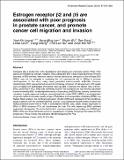Estrogen Receptor β2 and β5 are Associated with Poor Prognosis in Prostate Cancer, and Promote Cancer Cell Migration and Invasion

View/
Author
Leung, Yuet-Kin
Lam, Hung-Ming
Song, Dan
Levin, Linda
Ho, Shuk-Mei
Cheng, Liang
Note: Order does not necessarily reflect citation order of authors.
Published Version
https://doi.org/10.1677/ERC-09-0294Metadata
Show full item recordCitation
Leung, Yuet-Kin, Hung-Ming Lam, Shulin Wu, Dan Song, Linda Levin, Liang Cheng, Chin-Lee Wu, and Shuk-Mei Ho. 2010. Estrogen receptor β2 and β5 are associated with poor prognosis in prostate cancer, and promote cancer cell migration and invasion. Endocrine-Related Cancer 17(3): 675-689.Abstract
Estrogens play a pivotal role in the development and progression of prostate cancer (PCa). Their actions are mediated by estrogen receptors (ERs), particularly ERβ in the prostate epithelium. With the discovery of ERβ isoforms, data from previous studies that focused principally on the wild-type ERβ (ERβ1) may not be adequate in explaining the still controversial role of ERβ(s) in prostate carcinogenesis. In this study, using newly generated isoform-specific antibodies, immunohistochemistry (IHC) was performed on a tumor microarray comprised of 144 specimens. IHC results were correlated with pathological and clinical follow-up data to delineate the distinct roles of ERβ1, ERβ2, and ERβ5 in PCa. ERβ2 was commonly found in the cytoplasm and was the most abundant isoform followed by ERβ1 localized predominantly in the nucleus, and ERβ5 was primarily located in the cytoplasm. Logistic regression analyses demonstrated that nuclear ERβ2 (nERβ2) is an independent prognostic marker for prostate specific antigen (PSA) failure and postoperative metastasis (POM). In a Kaplan–Meier analysis, the combined expression of both nERβ2 and cytoplasmic ERβ5 identified a group of patients with the shortest POM-free survival. Cox proportional hazard models revealed that nERβ2 predicted shorter time to POM. In concordance with IHC data, stable, ectopic expression of ERβ2 or ERβ5 enhanced PCa cell invasiveness but only PCa cells expressing ERβ5 exhibited augmented cell migration. This is the first study to uncover a metastasis-promoting role of ERβ2 and ERβ5 in PCa, and show that the two isoforms, singularly and conjointly, have prognostic values for PCa progression. These findings may aid future clinical management of PCa.Other Sources
http://www.ncbi.nlm.nih.gov/pmc/articles/PMC2891483/pdf/Terms of Use
This article is made available under the terms and conditions applicable to Other Posted Material, as set forth at http://nrs.harvard.edu/urn-3:HUL.InstRepos:dash.current.terms-of-use#LAACitable link to this page
http://nrs.harvard.edu/urn-3:HUL.InstRepos:5141357
Collections
- HMS Scholarly Articles [17922]
Contact administrator regarding this item (to report mistakes or request changes)


